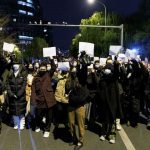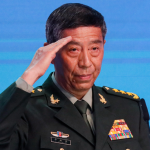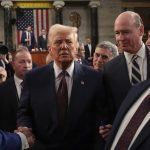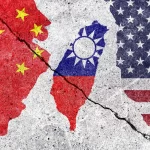By Bradley A Thayer
The ability of the United States to extend deterrence to key allies like Australia and Japan, and to partners like Taiwan, depends upon two considerations. First, there are political considerations, which include the credibility of the United States to honor its commitments and willpower to incur the risks inherent in providing another state the U.S. nuclear umbrella. Second, it requires sufficient military capabilities—the conventional and nuclear forces the United States possesses—to defeat the enemy’s military objectives or inflict unacceptable punishment upon the enemy.
The Biden administration publicly released three major policy documents: the National Defense Strategy (NDS), the Nuclear Posture Review (NPR), and the Missile Defense Review (MDR).
The NDS purports to advance a strategy focused on China. According to the NDS, this requires dissuading China from considering aggression as a viable means to advancing goals that jeopardize U.S. interests. The document states that the United States will deter China by leveraging existing and emergent force capabilities, posture, and activities to enhance denial and by strengthening resilience, the ability to withstand, fight through, and recover quickly from disruption. The NDS and NPR tout the advantages that will come from the modernization of the nuclear triad and nuclear command, control, and communications (NC3) systems.
At the same time, the administration has stated in the NPR that it will cancel the nuclear-capable sea-launched cruise missile (SLCM-N) and will retire the multi-megaton B-83-1 gravity bomb.
Moreover, the U.S. Air Force’s plan is to replace the F-15 fleet at Kadena Air Force Base on Okinawa with a rotational force, which likely will include the deployment of F-22 from Alaska, after the F-15s depart. However, this raises concerns about gaps in force structure and precisely what forces and when those forces will be present on the island. This move should have only been executed if there had been no gap in capability and the F-15s were permanently replaced with the right number of aircraft with superior capability to the F-15. As it stands, this step diminishes the ability of the United States to offer a conventional deterrent to China in the Indo-Pacific.
The Biden administration is weakening the ability of the United States to extend conventional or nuclear deterrence credibly in the Indo-Pacific.
There are three major problems with the Biden administration’s strategy documents. First, it assumes that modernization of the triad, which is occurring this decade, will be sufficient for meeting U.S. extended deterrent obligations. Only a small number of tactical nuclear weapons and no theater systems will be in the U.S. arsenal. In essence, and rejecting the force posture of the Cold War where considerable capabilities were devoted to tactical and theater nuclear weapons, there are no rungs on the escalation ladder for the United States. Thus, Washington will be compelled to move from conventional war to a strategic nuclear exchange. This gives every reason for China to expand its tactical and theater systems, as well as its conventional systems, to convey to the United States a willingness to escalate to tactical nuclear weapons if its conventional military is losing, as Vladimir Putin is signaling now with Russian threats to escalate by employing tactical nuclear weapons to terminate the war—“escalating to de-escalate” as Russian doctrine identifies. China would also have options the U.S. does not to escalate to the theater level, thus keeping a nuclear conflict localized and leaving the decision to the United States to escalate to a limited or major exchange between the strategic arsenals of the two countries. Moreover, the United States faces Russia as well, so the U.S. strategic nuclear arsenal is already taxed.
Second, collectively these documents assume that the U.S. has time, that the U.S. can wait while its strategic systems are modernized and the right conventional force posture provided for deterrence—the enemy will not act before then. In fact, the Chinese regime has stated, most recently at October’s 20th Party Congress, that the United States is their foe, and they are determined to conquer Taiwan. They have reason to act before the triad is modernized and the U.S. and Taiwan can deploy the right force structure for their respective forces. So, if the U.S. enemy were to act on its timeframe, believing that it is better to act now, immediately or in the near term, rather than later to bring about the changes it seeks in global politics, then the United States faces a new window of vulnerability. The Chinese regime has the incentive to employ coercive measures against Japan, India, the Philippines, or Taiwan now when the U.S. is still on the back foot, rather than many years into the future.
Third, the troika of documents was a rare and wasted opportunity to convey to the world that the United States will meet its extended deterrence requirements by explaining what steps the administration was taking to meet the grave threat. Each could have explained the threat from the Chinese regime and what the U.S. defense strategy was to match the threat and defeat it, with additional details provided on nuclear issues in the NPR and on ballistic, hypersonic, and cruise missile defenses in MDR. Each could have employed the lessons of the Cold War when the U.S. extended deterrent worked in difficult circumstances. Instead, the administration has produced reports that signal U.S. weakness, uncertainty, and an absence of strategic focus on the threat. While the threat from China is growing, the Biden administration is weakening U.S. military capabilities. Xi has been emboldened due to his triumph at the 20th Party Congress, he has stated his intent to replace the United States and conquer Taiwan, and his perception of U.S. weakness may invite his aggression and cause the failure of the U.S. extended deterrent.
This article first appeared in The Epoch Times on 10/29/2022





















